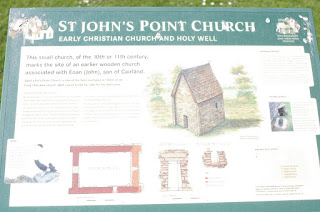Bullauns are stones with a bowl-shaped depression where water can collect, they are commonly found in Ireland at ecclesiastical sites, and the water in them often used as a cure for headaches. Those who are interested in the New Age line on 'megaliths' invest them with a deep significance, but a more prosaic explanation is that they are simply discarded quern stones. This is the bullaun from Saint John's Point, the step down leads to the well:
So what do we know of this Saint John? Alas, nothing of his life, but the church is mentioned in medieval records:
St. John's Chapel was valued at three marks in the Taxation of Pope Nicholas, under the name of "the chapel of Styoun," which name seems to have been formed from the Irish words Tigh-Eóin, "John's house." In the calendar of the O'Clerys, the festival of its patron is mentioned on the 17th of August, "Eóin MacCarlain, of Teac Eóin." Immediately after the coming of the English, Malachi, Bishop of Down, granted the church of "Stechian" to the Abbey of Down. At the Dissolution the tithes of this chapel, under the name of St. Johnstown, were appropriate to the Preceptory of St. John in the Ards. The church, which was of a very ancient style of architecture, measured twenty by thirteen feet in the clear.
Fr J. O'Laverty, An Historical Account of the Diocese of Down and Connor Vol 1, (Dublin, 1878), 152-3.
Thus Saint John, Eóin son of Carlan, is one of the many Irish saints about whose life nothing is known, but whose memory has survived in the placenames and ruins of the locality in which he flourished. May he continue to bless County Down and its people.
Content Copyright © Omnium Sanctorum Hiberniae 2012-2015. All rights reserved.
Content Copyright © Omnium Sanctorum Hiberniae 2012-2015. All rights reserved.




1 comment:
Enjoyed that item, as I holidayed in that area last year and photographed those very same items. Met many nice people at the site also.
Post a Comment